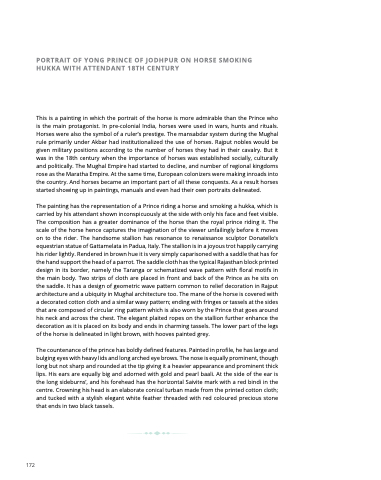Page 178 - Eye of the beholder
P. 178
PORTRAIT OF OF YONG PRINCE OF OF JODHPUR ON ON HORSE SMOKING HUKKA WITH ATTENDANT 18TH CENTURY
This is is is a a a a a a painting in in in in which the the the portrait of the the the horse is is is more admirable than the the the Prince who is is the main protagonist In In pre-colonial India horses were used in in wars hunts and rituals Horses were also the the symbol of a a a a a a ruler’s prestige The mansabdar system during the the Mughal rule primarily under Akbar had institutionalized the use of horses Rajput nobles would be given military positions according to the the the number of horses they had in in their cavalry But it it it was was in the the 18th century when the the importance of horses was was established socially culturally and and politically The Mughal Empire had started to decline and and number of regional kingdoms rose as the the Maratha Empire At the the same time European colonizers were making inroads into the the country And horses horses became an an important part of all these conquests As a a a a a a result horses horses started showing up in in in in in paintings manuals and even had their own portraits delineated The painting has the representation of a a a a a a a a Prince riding a a a a a a a a horse and smoking a a a a a a a a hukka which is carried by his his attendant shown inconspicuously at at the side with only his his face and feet visible The The composition has a a a a a a greater dominance of the the horse than the the royal prince riding it it The The scale of of the the the horse hence captures the the the imagination of of the the the viewer unfailingly before it moves on on on on to to to the rider The handsome stallion has resonance to to to renaissance sculptor Donatello’s equestrian statue of Gattamelata in in in Padua Italy The stallion is in in in a a a a a a a a a a a a a joyous trot happily carrying his rider lightly Rendered in brown hue it it is is is very simply caparisoned with a a a a a a saddle that has for the the the hand support the the the head of a a a a a a a a a a parrot The saddle cloth has the the the typical Rajasthan block printed design in in its border namely the Taranga or or or schematized wave pattern with floral motifs in in the the main body Two strips of of cloth are placed in in in front and back of of the the Prince as he he he sits on on the saddle It has a a a a a a a design of geometric wave pattern common to relief decoration in Rajput architecture architecture and a a a a a a ubiquity in Mughal architecture architecture too The mane of the horse is covered with a a a a a a a a a decorated cotton cloth and a a a a a a a a a similar wavy pattern ending with fringes or or tassels at at at the sides that that are composed of circular ring pattern which is also worn by the Prince that that goes around his neck and across the the the the chest The elegant plaited ropes on on the the the the stallion further enhance the the the the decoration as as it it is placed on on its body and ends in in charming tassels The lower part of the legs of the horse is delineated in in in light brown with hooves painted grey The countenance of o the prince has has boldly defined features Painted in fin in in profile he he he has has large and bulging eyes with heavy lids and long arched eye eye brows The nose is equally prominent though long but not sharp and and rounded at the tip giving it a a a a a a a a a heavier appearance and and prominent thick lips His ears are equally big and and adorned with gold and and pearl baali At the the side of the the ear ear ear is is the the the long sideburns’ and his forehead has the the the horizontal Saivite mark with a a a a a a a red bindi in in the the the centre Crowning his head is is an an elaborate conical turban made from the printed cotton cloth and tucked with with a a a a a stylish elegant white feather threaded with with red red coloured precious stone that ends in two black tassels 172


